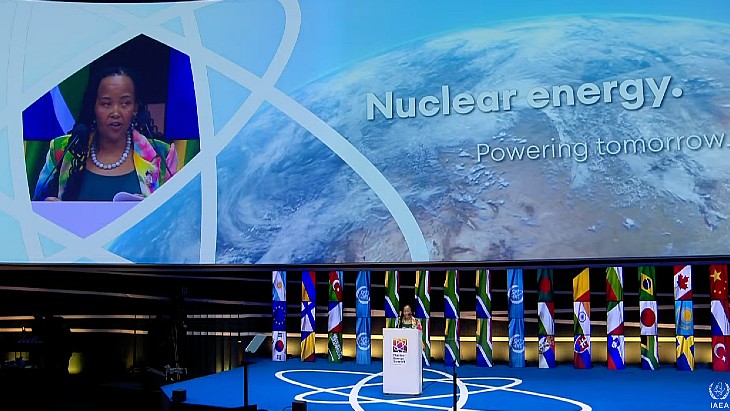As well as preparing to issue a Request for Proposals for 2500 MW of new nuclear "this calendar year", the Nuclear Energy Summit was told that South Africa is developing its Pebble Bed Modular Reactor technology and "deserves the opportunity to implement the complete nuclear fuel cycle for peaceful uses".

The Nuclear Energy Summit was held in Brussels (Image: Screengrab from IAEA feed)
Tokozile Xasa, South Africa's ambassador to Belgium, Luxembourg and the European Union, gave an outline of South Africa's nuclear energy ambitions at the international summit organised jointly by the International Atomic Energy Agency and Belgium.
She said that while South Africa has 93% access to electricity, there are 600 million people on the African continent that do not, and South Africa believes that "if we are to eradicate poverty, unemployment, and inequality in Africa, we need to get rid of energy poverty and guarantee energy security".
As part of its diversified energy mix nuclear has a role, she said, with the Koeberg nuclear power plant, the only operating nuclear power plant in Africa, set to have its life extended by a further 20 years. The Request for Proposals for 2500 MWe of nuclear new build - which had originally been due to be issued this month - would be "issued to the market within this calendar year", she added.
In the light of the continent's rich resources, including uranium, "South Africa intends on leveraging on the beneficiation of these resources to produce feedstock for Africa's nuclear power plants whilst developing its own Pebble Bed Modular Reactor technology as a strategic project considering all required approvals. Based on our track record of producing Pebble Bed fuel, South Africa further intends on leveraging its natural resources to become a global supplier of a High Temperature Reactor fuel, followed by a Multipurpose Reactor technology envisaged for commercial deployment beyond 2030".
South Africa’s Nuclear Energy Corporation (Necsa) is also currently working on a feasibility study on a new reactor to succeed the SAFARI-1 research reactor which has been operating for 58 years. The Multipurpose Reactor is envisaged by Necsa as having a power level of 20-30 MWe with irradiation facilities for material testing and isotope production as well as beam line facilities.
Xasa added: "Given all these realities, we firmly believe that in order to obtain all the potential economic benefits from nuclear and to achieve a self-sufficiency goal, South Africa deserves an opportunity to implement the complete nuclear fuel cycle for peaceful uses in line with our nuclear energy policy."
South Africa published a draft Integrated Resource Plan (IRP 2023) in January including different combinations of nuclear, renewables, clean coal and gas to provide security of supply as well as supporting carbon reduction commitments, with final policy decisions to "be taken on the basis of a longterm decarbonisation trajectory" while improving South Africa's competitiveness and economic growth.
South Africa's Pebble Bed Modular Reactor was to have been a small-scale high-temperature reactor using graphite-coated spherical uranium oxycarbide tristructural isotropic (TRISO) fuel, with helium as the coolant, able to supply process heat as well as generating electricity. The nature of the fuel in particular gives the reactor a high degree of passive safety, exploiting inherent safety characteristics depending on the physical properties of the system without the need for intervention.
Based on well-proved German technology, South Africa had been working on the PBMR project since 1993, however, in 2010 the government formally announced its decision no longer to invest in the project, which was then placed under 'care and maintenance' to protect its intellectual property and assets. Former chairman of the South African Nuclear Energy Corporation, Kelvin Kemm, chairman and CEO of Stratek Global, told World Nuclear News last year that with the legacy and experience of the PBMR project, its High Temperature Modular Reactor (HTMR-100) could see a first-of-a-kind 35 MWe unit built within five years.
The Nuclear Energy Summit - which the organisers described as the first of its kind - saw leaders and representatives from 32 countries backing a joint declaration setting out actions needed to achieve the necessary expansion of nuclear capacity to tackle climate change and boost energy security.